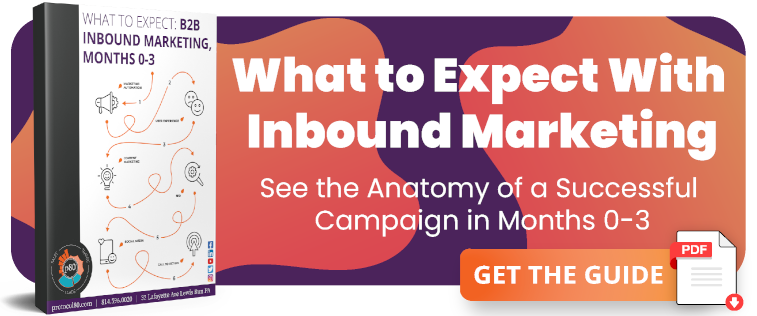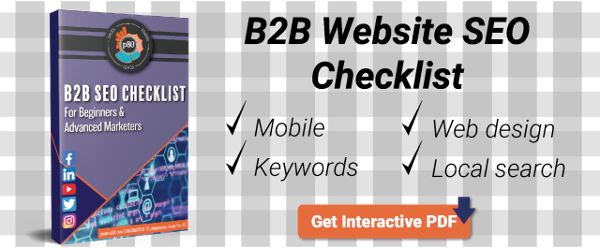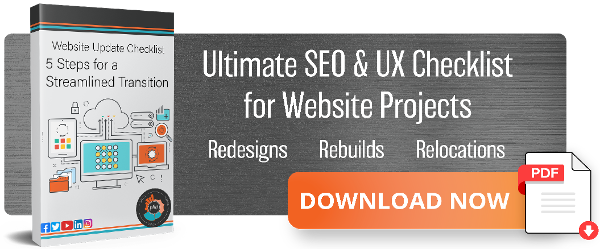Inbound Marketing Blog
for Manufacturers and Healthcare Companies
How to Build a B2B Website Strategy That Generates Leads

“Our company has a website.”
Is that all you can muster when someone asks about your online marketing strategy? You may have a problem.
Looking For a Deeper Dive?For a deeper dive into the topic, watch the video version of this article! Josh Curcio, certified HubSpot trainer, and Holly McCully, inbound marketing consultant at protocol 80, Inc., share real examples of B2B website development successes and faux pas. They talk with Donny Kemick, founder of p80, who shares his 20 years of expertise in manufacturing and industrial website development. |
Perhaps your problem started years ago when you heard you had to have a website to be modern. So, you created or redesigned your website with little thought about a business-to-business (B2B) website strategy. And now it’s been ages since anyone has updated its content.
You don’t sell anything on it. You have a long sales cycle that depends on a lot of offline relationship building.
So, why should your website, y'know ... not suck?
Potential leads. They often come to your website for solutions to problems long before they’re ready to buy. B2B leads are judging your website, whether you know it or not. They'll look for your competitor if they can’t find help from you that moves them closer to a solution.
B2B website development is crucial for turning potential leads into clients and keeping clients satisfied.
6 Tips For Developing a B2B Website Strategy

B2B website development takes serious consideration. At a minimum, a good B2B website strategy should include:
Unfortunately, these steps don’t always happen.
1. PLAN first, then act.
"I'm a dog chasing cars. I wouldn't know what to do with one if I caught it! Y'know, I just do things."
--The Joker, "The Dark Knight"
This approach to business (mostly) worked for Heath Ledger's legendary character, but it probably won't for your B2B website strategy.
Before cranking the efforts up to 11, develop a comprehensive plan that outlines your:
- Goals – The big picture of what you want to accomplish for your business, and in how long
- Performance metrics – The criteria you'll use to measure success along the way
- Scope – How far and wide efforts will go. For example, will you redesign your website? Migrate it? Build a new one from scratch?
- Roles & responsibilities – Make it clear who's on the hook for providing background knowledge, existing assets (i.e. images and sales decks), and reviews/approvals
By getting all stakeholders to agree on the project's parameters up-front, you'll start attracting leads sooner. Just be sure to leave a smidgeon of room for pivoting if a unique opportunity or need comes up.
After that, use analytics tools to track what's going well and not-so-well. After initial rollout, every 3 months is a good cadence for creating a new mini-strategy based on what the traffic, lead, and sales data is telling you. (Just don't throw the big-picture plan out the window if numbers start slow -- inbound marketing usually takes 6-12 months to gain traction.)
2. UX best practices should come next.
Website user experience (UX) is the concept of how a user will move around and interact with your pages. Much like a restaurant with great food but rude waiters and crumbs on the table, a great company can be ruined by a crappy digital presence.
Important elements of B2B web UX include:
- Navigation – Clearly labeled & organized info that's easy to find and move across
- Accessibility – Easy to read & use, especially for visitors with impairments
- Performance – Loads quickly; technical issues are minimal
When technical issues do occur, squash them ASAP before site rankings tank.
Mobile Matters, Even in B2B
In a world where nearly everyone has a mobile device in their pocket, optimizing your website for mobile traffic is a no-brainer. While mobile use is more common on the B2C side, it still makes up 20-35% of B2B traffic.
Web design with clunky menus, small buttons, and desktop-only formatting creates a terrible user experience for mobile viewers. However, it’s never been easier to make your website mobile-friendly, so there’s no excuse for having your website display poorly on a visitor’s smartphone.
Ensuring your website is optimized for mobile means more than simply making a few aesthetic tweaks. A site’s mobile version should build a customer journey that’s responsively designed, relevant, actionable, and frictionless.
Google indexes your site based on how a mobile device renders it, so test your website on a smartphone or tablet before launching it. Doing so helps your mobile experience look like a priority rather than an afterthought.
3. CONTENT should be customer-centric.
Your entire website creation strategy should orbit around addressing buyer problems and opportunities. Your homepage, landing pages, and other key pages should clearly describe:
- What you do
- Who it's for
- How they'll benefit
Indirectly, this mindset extends to your inbound marketing assets -- in other words, your:
- Blog posts
- Videos
- Marketing emails
- Social media posts
Buyers don't visit your website because they love lengthy sales pitches or because they found your company Christmas card positively enchanting. Engaging and helpful B2B marketing content is what keeps people on your website longer and moves them along their buyer’s journey.
B2B website marketing doesn't mean tossing up content for content’s sake. That's not helpful. Develop a B2B website content strategy that focuses on attracting great-fit visitors and converting them into leads to pass on to the sales team.
Let’s say a visitor comes to your services page. You’re not helping them by only giving them a picture with a one-sentence description. Give visitors information on benefits, applications, and drawbacks that help them in their buyer’s journey.
There’s not a one-size-fits-all number when it comes to content length. However, having at least 600 words for a blog post and 300 words for most other pages gives your content a little weight. As the best B2B blog examples show, in-depth blog content often requires 1,000+ words to quench the reader's knowledge thirst, depending on your buyer persona.
Longer content (2,000+ words) tends to perform better for search engine optimization (SEO), but no one wants to read your 20,000-word tome on your latest product or service. Consider breaking up super-long content into a pillar page or a premium offer, like an e-book.
4. CONVERSION paths should lead visitors in the right direction.
A call to action, or CTA, is a lead-generation tactic that prompts a prospect to take the next step. CTAs can be text-based (click here to learn more about CTAs) or be an image or button:
Whether calling leads to sign up for a free e-book or a free consultation, any CTA you offer should provide more value. That way, the prospect will want to hear from you again – or at least they will have a favorable opinion of you when they come across your brand again.
Your CTAs should lead to a landing page where prospects provide contact details (and perhaps other data valuable to your B2B digital marketing strategy) in exchange for a resource. The reward doesn't have to be an e-book or consultation – you can also offer:
- Buying a product/service
- Opting into a mailing list
- Requesting a quote
- Making a donation
- Answering a survey
- And more
Landing pages help supplement other marketing tactics, both online and off. By directing clicks to a landing page, you can increase the success rate of many marketing tactics:
By directing these tactics to a unique landing page, you can accurately measure the effectiveness and ROI of your other marketing tactics.
5. SEO gets your site in front of buyers.
If you want more traffic on your website, make sure people can find you. You want your website to appear at the top of search results. You’ll need to adjust the way you write copy for your website.
Don’t just guess what adjustments are needed. Run your website through an SEO audit. You can’t see everything that needs adjusting with your own eyes. The tool will catch what you can’t see. Companies like HubSpot and SEMrush have website grader tools. You should aim for an optimization score of 92% or higher.
However, tools can’t tell you everything. Consider doing buyer interviews and asking customers if your website still serves them. If your market has changed, consider how to reposition yourself in that market.
Listen to the way they refer to their challenges and your products and services, as this can inform the keywords you choose to target.
For example, we have a client who recently increased their emphasis on helping engineers in the electric vehicle space, which wasn’t their priority when we started with them four years ago. We've optimized their website from a technical and positioning standpoint.
Several other SEO factors determine Google rankings, so pay attention to your:
- Page speed
- Title tag
- Meta description
- Headings

6. DESIGN should be clean and modern.
There's a reason this is the caboose of the list. Too many execs and marketing managers put all their eggs in the "flashy = good" basket.
In manufacturing and other industrial markets, good website design is important. However, function is arguably more important than form.
There are plenty of stylish websites out there. You don’t necessarily need to build yours from scratch. Take some inspiration from great website designs.
Your website should match the expectation of your user. Say you’re a CNC machining company. You see an elegant, trendy site for an architectural firm. You may love the look, but does this align with your industry or customers? Research what visitors expect from your industry – both in aesthetics and functionality – or you may turn them away.
Don’t bury important information beneath 27 videos vaguely touting your amazingness. (Besides, that'll probably slow your site loading speed to the point it hurts SEO rankings.) People are coming to your site with a variety of needs. They want to know:

- What makes your solution unique?
- Can they see your product/service in action?
- Which industries do you serve?
- What’s your radius of service?
- How can they contact you?
Don’t make visitors hunt for this information. Make it simple to find, or they’ll get frustrated and look for a competing site.
Don’t be afraid to seek professional help with web design. Companies like Wix, Squarespace, and GoDaddy have made web design accessible to the average person. But, just because you can do it doesn’t mean you should.
Side note: We’ve has moved several clients from the companies mentioned above due to their limitations. They may not support e-commerce or blogging in the way a client likes. Clients may not be able to customize templates as they want. Web designers can help you build a customized, aesthetically pleasing, functional, and strategic website.
Important Assets for B2B Website Development
Building a website that drives traffic isn’t easy. A good B2B website strategy includes the following tools:
- A reliable site host & CMS (content management system): HubSpot or WordPress, for example.
- High-quality content: Engaging and informative text, images, and video should be part of your B2B content strategy.
- Secure Sockets Layer (SSL) certificate: Google won’t rank you without a safe, trustable website.
- Contact Us or RFQ forms: Forms for any conversion opportunity are the key to growing revenue through your website.
- Google Tag Manager: You can track how elements of your site perform. (Why would you have a website without this?)
- Web developer: In-house, outsourced, whatever. Just get one, or you’ll burn valuable resources.
- A good domain name: Something that represents your business is ideal.
- A cup of coffee: Maybe you need two or three.
'We Don’t Do E-Commerce. Why Do We Need a (Good) Website?'
Your customers may not fill a virtual shopping cart on your website. But they’ll most likely spend significant time on your site before purchasing from you.
B2B clients are already up to 70% done with the buying process before they talk to a salesperson. They have a problem. They Google it. They research. They may even submit their contact information in exchange for an e-book you published. Now you have a lead – maybe not one ready to buy, but one you can nurture.
The sales process starts online, whether you like it or not. And if you're not using your website to attract leads, you’re leaving leads on the table for your competitors to grab.
Your B2B Website Is a Revenue Generator
As you continue to develop your website, let the tips above guide you. Don’t just wing it because you feel obligated to have one. Make sure it’s professionally designed and easy to navigate, with informative content that facilitates lead capturing.
Use tools that show you how your website performs and what needs to be optimized.
Don’t let your website be an afterthought – it should be the centerpiece of your B2B growth strategies. Potential clients are searching the internet for answers that you have. Be ready to guide them to a solution.
Optimize Your Website. We can Help!
Months 0-3 are critical for starting a B2B digital marketing campaign.
Need help getting your website up to speed? We’ll give it a look-over and show you where you can optimize your website to attract great-fit traffic and leads.
(Editor's note: This article was originally published in January 2022 and was recently updated.)
Our Blogs, Direct to Your Inbox!
How to Audit your Online Marketing
If you are executing digital marketing, congratulations! You are most likely already one step ahead of your competition, and making strides to meaningfully connect with prospects online. But, how do you know if you’re seeing continual success year over year, and improving your metrics?
Without the tools in place to analyze and benchmark your efforts, it is impossible to scale your online marketing and ensure continuous success.




